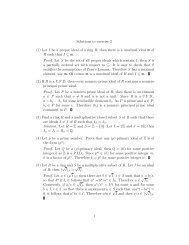Topics in algebra Chapter IV: Commutative rings and modules I - 1
Topics in algebra Chapter IV: Commutative rings and modules I - 1
Topics in algebra Chapter IV: Commutative rings and modules I - 1
You also want an ePaper? Increase the reach of your titles
YUMPU automatically turns print PDFs into web optimized ePapers that Google loves.
Proof. Let M be an R-module. S<strong>in</strong>ce M is an abelian group, M is embedded<br />
<strong>in</strong> an <strong>in</strong>jective Z-module D. By the previous lemma, HomZ(R, D) is an<br />
<strong>in</strong>jective R-module. Therefore, to f<strong>in</strong>ish the proof, it rema<strong>in</strong>s to show that M<br />
is an R-submodule of HomZ(R, D). Notice that the group monomorphism<br />
M −→ D <strong>in</strong>duces the R-monomorphism HomZ(R, M) −→ HomZ(R, D).<br />
Moreover, let i : M −→ HomZ(R, M) be the map given by i(x)(r) = xr for<br />
x ∈ M <strong>and</strong> r ∈ R; then it is easy to check that i is an R-monomorphism.<br />
We now conclude that M is an R-submodule of HomZ(R, D).<br />
Proposition 5.15 Let R be a r<strong>in</strong>g. Then the follow<strong>in</strong>g are equivalent for<br />
an R-module E:<br />
(a) E is <strong>in</strong>jective.<br />
(b) Any s.e.s. of the form 0 −→ E f<br />
−→ M g<br />
−→ N −→ 0 splits.<br />
(c) E is a direct summ<strong>and</strong> of any R-module M of which it is a submodule.<br />
Proof. (a) ⇒ (b) Let 0 −→ E f<br />
−→ M g<br />
−→ N −→ 0 be a s.e.s.. Let i : E −→<br />
E be the identity map; then there is a R-homomorphism h : M −→ E such<br />
that h ◦ f = i, so that h ◦ f = idE,i.e., the s.e.s. splits.<br />
(b) ⇒ (c) Suppose E is a submodule of M. Then there is a s.e.s. 0 −→<br />
E i<br />
−→ M π<br />
−→ M/E −→ 0. S<strong>in</strong>ce it splits, E is a direct summ<strong>and</strong> of M.<br />
(c) ⇒ (a) S<strong>in</strong>ce E can be embedded <strong>in</strong> an <strong>in</strong>jective R-module E ′ by the<br />
previous corollary <strong>and</strong> E is a direct summ<strong>and</strong> of E ′ by assumption, therefore<br />
E is an <strong>in</strong>jective module.<br />
Problem set<br />
1. Let R be a field; then every module is free.<br />
2. The follow<strong>in</strong>g are equivalent for a r<strong>in</strong>g:<br />
(a) Every R-module is projective.<br />
(b) Every s.e.s. splits.<br />
(c) Every R-module is <strong>in</strong>jective.<br />
3. Let E be an R-module; then E is <strong>in</strong>jective if <strong>and</strong> only if for every ideal<br />
I <strong>and</strong> R-homomorphism g : I −→ E there is an element x ∈ E such that<br />
136



